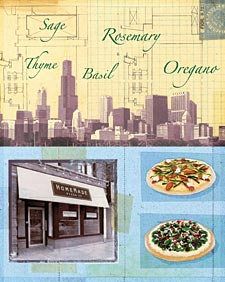Last fall, the head of a storied Chicago architectural firm made a surprising announcement. He was leaving Graham Anderson Probst & White-a firm that had descended from Daniel Burnham himself-for a pizza company. A pizza com-pany? Surely this was the first such announcement in the history of architecture and pizza, two beloved Chicago institutions whose paths rarely cross. But Bob Surman didn’t leave for just any pizza company. He left to become chief architect for HomeMade Pizza Company, a tableless, ovenless pizzeria in 12 Chicago neighborhoods and suburbs. Customers select from a list of ingredients and leave with a pie they cook at home in about ten minutes. In 2006, that translated to sales of nearly 1,000 pizzas a day, for a projected revenue of $5 million for the year. By the end of 2007, HomeMade will have doubled its number of stores and expanded into Minneapolis, its first venture outside of the Chicago area. The secret to the pizzeria’s rapid growth, analysts say, is its image, a model that some call “boutique food.” Outside, the sleek minimalist exterior says high-end retail. Inside, pink prosciutto, leafy spinach, and ripe sun-dried tomatoes line up like baubles in a pristine stainless steel and glass cabinet. This aesthetic, as well as the stores’ strategic locations-situated among trendy bars, stylish shops, and art galleries-help HomeMade appeal to a specific clientele: urban foodies concerned with quality. “This is for a customer who has progressed beyond fast food,” says Neil Stern, of the Chicago retail consultants McMillan Doolittle LLP. Founders Eric and Audrey Fosse decided more than a decade ago that they had reached that point. They were new parents living in New York; Eric was in the diamond business, and Audrey, who had previously been a modern art curator for the Art Institute of Chicago, was taking time off to be a new mom. There wasn’t time to cook-an issue, because the couple wanted to maintain a tradition of family dinners. A few years after visiting a similar operation in Colorado, the Fosses moved back to Chicago, their hometown, to start making pizzas. In 1997, along with Audrey’s brother Matthew Weinstein, they opened the first HomeMade in Lake View. Other take-and-bake pizza chains, such as Nick-n-Willy’s and Papa Murphy’s, had entered Illinois, but had not managed to crack the Chicago market. One difference between the value-oriented Murphy’s and HomeMade Pizza is the ingredients; regional items like Wisconsin mozzarella make up 30 percent of HomeMade Pizza’s costs, 10 percent more than at most pizzerias. (HomeMade’s pizzas start at about $10, while Nick-n-Willy’s and Murphy’s start at $4 and $8, respectively.) Another difference is the company’s investment in its brand. Glenn Deutsch, formerly of Three Communication Design, worked with Audrey Fosse to develop the stores’ cool, clean image. “We wanted to build a faceless brand with a clear message,” says Deutsch, now on staff at the pizza company. “The food is the focus.” Then, in the fall, the team lured Surman away from Graham Anderson. “There are architects out there who can’t figure out why I made the change,” Surman says. An early investor in the company, he had been friends with the Fosses for 30 years and had drawn the plans for the majority of stores. As the company expands, Surman’s oversight will help maintain a crucial element: consistent, modern design. Fortunately for HomeMade, Surman’s vision for his own architectural career is a little more flexible. “It was an exciting opportunity. I’ve designed skyscrapers,” Surman says. “This is just another portion of my career.” |
||



